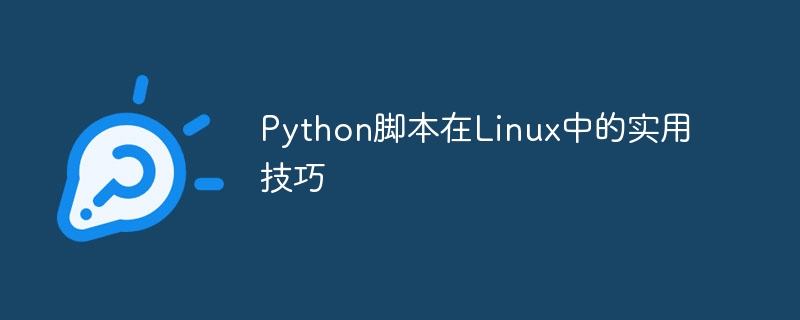Practical tips for Python scripting in Linux

Practical tips for Python scripting in Linux, specific code examples are required
Introduction:
Python is a programming language that can be widely used in various fields , and Linux, as a free and open source operating system, is widely used in servers, embedded devices and other fields. In the Linux environment, Python scripts can exert powerful power to help us complete various tasks. This article will introduce some practical tips for using Python scripts in Linux and provide specific code examples.
1. Combining Shell Commands with Python
In Linux, we often need to use Shell commands to perform some system-level operations. Python provides the os module and the subprocess module, which can easily call Shell commands. Here are some common examples:
1. Execute a Shell command and get the output:
import subprocess
result = subprocess.check_output("ls -l", shell=True)
print(result.decode())2. Execute multiple Shell commands:
import subprocess
commands = [
"sudo apt update",
"sudo apt upgrade -y",
"sudo apt install python3-pip -y",
]
for cmd in commands:
subprocess.call(cmd, shell=True)3. Restart via Shell command Directed output:
import subprocess
with open("output.txt", "w") as f:
subprocess.call("ls -l", shell=True, stdout=f) 2. File and directory operations
File and directory operations in Linux systems are frequently encountered tasks. Python provides the os.path module and ## The #shutil module is used to process files and directories.
import os
os.makedirs("my_directory")import shutil
shutil.rmtree("my_directory")import os
for root, dirs, files in os.walk("my_directory"):
for file in files:
print(os.path.join(root, file))Network operations in the Linux environment are very common. Python provides the
socket module and the requests module to handle network requests.
import requests
response = requests.get("https://www.example.com")
print(response.text)import http.server
handler = http.server.SimpleHTTPRequestHandler
httpd = http.server.HTTPServer(("", 8000), handler)
httpd.serve_forever()import smtplib
from email.message import EmailMessage
msg = EmailMessage()
msg.set_content("Hello, World!")
msg["Subject"] = "This is a test email"
msg["From"] = "sender@example.com"
msg["To"] = "recipient@example.com"
with smtplib.SMTP("smtp.example.com") as server:
server.send_message(msg)This article introduces some practical skills for using Python scripts in Linux, including combination with Shell commands, file and directory operations, and network operations. Through these tips, we can better utilize the power of Python to complete various tasks. The above sample code is only a demonstration and readers can modify and expand it according to their actual needs.
The above is the detailed content of Practical tips for Python scripting in Linux. For more information, please follow other related articles on the PHP Chinese website!

Hot AI Tools

Undresser.AI Undress
AI-powered app for creating realistic nude photos

AI Clothes Remover
Online AI tool for removing clothes from photos.

Undress AI Tool
Undress images for free

Clothoff.io
AI clothes remover

Video Face Swap
Swap faces in any video effortlessly with our completely free AI face swap tool!

Hot Article

Hot Tools

Notepad++7.3.1
Easy-to-use and free code editor

SublimeText3 Chinese version
Chinese version, very easy to use

Zend Studio 13.0.1
Powerful PHP integrated development environment

Dreamweaver CS6
Visual web development tools

SublimeText3 Mac version
God-level code editing software (SublimeText3)

Hot Topics
 1386
1386
 52
52
 How to solve the permissions problem encountered when viewing Python version in Linux terminal?
Apr 01, 2025 pm 05:09 PM
How to solve the permissions problem encountered when viewing Python version in Linux terminal?
Apr 01, 2025 pm 05:09 PM
Solution to permission issues when viewing Python version in Linux terminal When you try to view Python version in Linux terminal, enter python...
 How to efficiently copy the entire column of one DataFrame into another DataFrame with different structures in Python?
Apr 01, 2025 pm 11:15 PM
How to efficiently copy the entire column of one DataFrame into another DataFrame with different structures in Python?
Apr 01, 2025 pm 11:15 PM
When using Python's pandas library, how to copy whole columns between two DataFrames with different structures is a common problem. Suppose we have two Dats...
 How to teach computer novice programming basics in project and problem-driven methods within 10 hours?
Apr 02, 2025 am 07:18 AM
How to teach computer novice programming basics in project and problem-driven methods within 10 hours?
Apr 02, 2025 am 07:18 AM
How to teach computer novice programming basics within 10 hours? If you only have 10 hours to teach computer novice some programming knowledge, what would you choose to teach...
 How to avoid being detected by the browser when using Fiddler Everywhere for man-in-the-middle reading?
Apr 02, 2025 am 07:15 AM
How to avoid being detected by the browser when using Fiddler Everywhere for man-in-the-middle reading?
Apr 02, 2025 am 07:15 AM
How to avoid being detected when using FiddlerEverywhere for man-in-the-middle readings When you use FiddlerEverywhere...
 What are regular expressions?
Mar 20, 2025 pm 06:25 PM
What are regular expressions?
Mar 20, 2025 pm 06:25 PM
Regular expressions are powerful tools for pattern matching and text manipulation in programming, enhancing efficiency in text processing across various applications.
 How does Uvicorn continuously listen for HTTP requests without serving_forever()?
Apr 01, 2025 pm 10:51 PM
How does Uvicorn continuously listen for HTTP requests without serving_forever()?
Apr 01, 2025 pm 10:51 PM
How does Uvicorn continuously listen for HTTP requests? Uvicorn is a lightweight web server based on ASGI. One of its core functions is to listen for HTTP requests and proceed...
 What are some popular Python libraries and their uses?
Mar 21, 2025 pm 06:46 PM
What are some popular Python libraries and their uses?
Mar 21, 2025 pm 06:46 PM
The article discusses popular Python libraries like NumPy, Pandas, Matplotlib, Scikit-learn, TensorFlow, Django, Flask, and Requests, detailing their uses in scientific computing, data analysis, visualization, machine learning, web development, and H
 How to dynamically create an object through a string and call its methods in Python?
Apr 01, 2025 pm 11:18 PM
How to dynamically create an object through a string and call its methods in Python?
Apr 01, 2025 pm 11:18 PM
In Python, how to dynamically create an object through a string and call its methods? This is a common programming requirement, especially if it needs to be configured or run...




